Discover 35 hidden attractions, cool sights, and unusual things to do in Wakefield (United States). Don't miss out on these must-see attractions: Lake Quannapowitt, Lakeside Cemetery Chapel, and Greenwood Union Church. Also, be sure to include Church–Lafayette Streets Historic District in your itinerary.
Below, you can find the list of the most amazing places you should visit in Wakefield (Massachusetts).
Table of Contents
Lake Quannapowitt
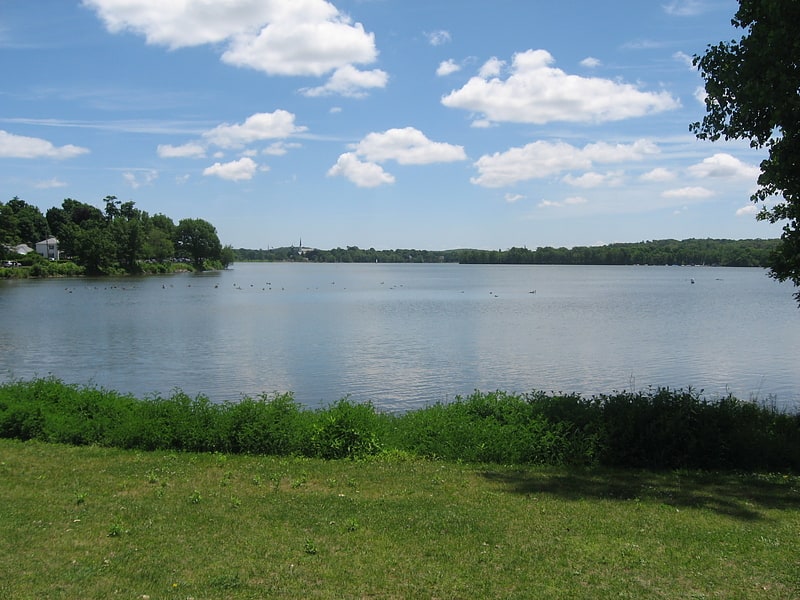
Lake in Massachusetts. Lake Quannapowitt a lake in Wakefield, Massachusetts named for Quonopohit, the Naumkeag Native American who signed a deed to the town that would become Wakefield in 1686. It is one of two large lakes in Wakefield, the other being the man-made Crystal Lake. Lake Quannapowitt is a popular setting for walkers, joggers, bikers, and in-line skaters off Route 128 in Middlesex County. It is the site of many organized races from 5Ks to Ultra Marathons. Since 1992, Friends of Lake Quannapowitt is an organization that has worked to fulfill its goal of promoting public awareness and providing long-term protection and enhancement of Lake Quannapowitt and its environs. Large amounts of tar were found in the lake some years ago. The lake is emptied by the Saugus River.
Lake Quannapowitt (KWAN-ah-POW-it / KWAN-ə-POW-it), which was originally known as Reading Pond, has numerous nicknames today. Some area natives refer to the lake as "Lake Quannapolluted" due to their view of the state of health of the lake, but the Massachusetts Department of Environmental Protection handled only one isolated open case of contamination from the electric company that was remediated in 2008. The two former beaches remain closed to swimming, due to arsenic which was introduced into the lake in the early 1960s to handle aquatic weeds.
The town common of Wakefield is on the south shore of the lake. Probably the most well known scene in the town is of its iconic bandstand on the town common, with Lake Quannapowitt in the background.
The lake has active populations of warmwater species of fish.[1]
Lakeside Cemetery Chapel
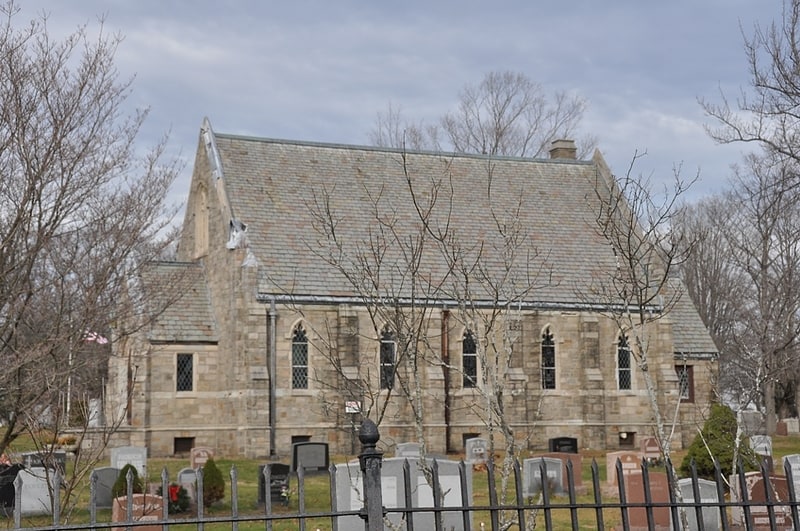
Chapel in Wakefield, Massachusetts. The Lakeside Cemetery Chapel is a historic chapel in Lakeside Cemetery, on North Avenue in Wakefield, Massachusetts. The stone chapel, built 1913, is one of a few Neo-Gothic buildings in the town. Roughly resembling English country churches, the building has a steeply pitched slate roof, with sidewalls containing supporting buttresses. The front and rear of the chapel both have projecting entry sections that repeat the sharply pitched gable.
The chapel was listed on the National Register of Historic Places in 1989.[2]
Greenwood Union Church
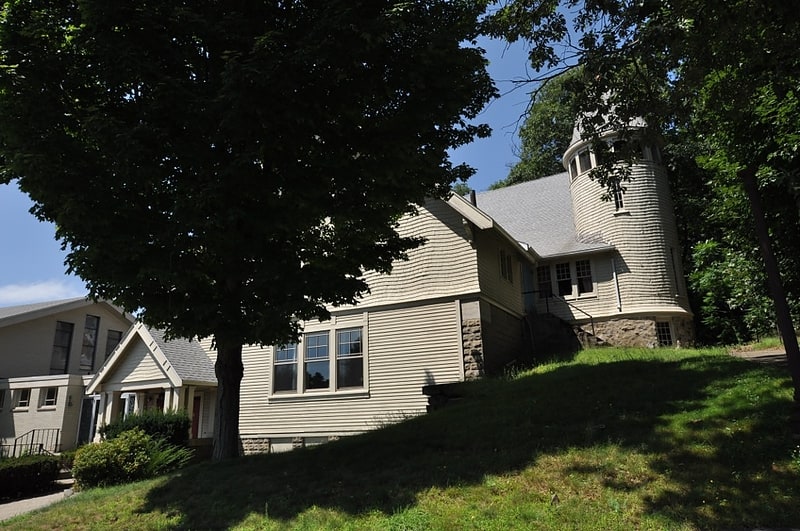
Christian church in Wakefield, Massachusetts. Greenwood Union Church is a historic church at 4 Oak Street in Wakefield, Massachusetts. The church was built in 1884 and added to the National Register of Historic Places in 1989.[3]
Address: 4 Oak St, 01880 Wakefield (Wakefield)
Church–Lafayette Streets Historic District
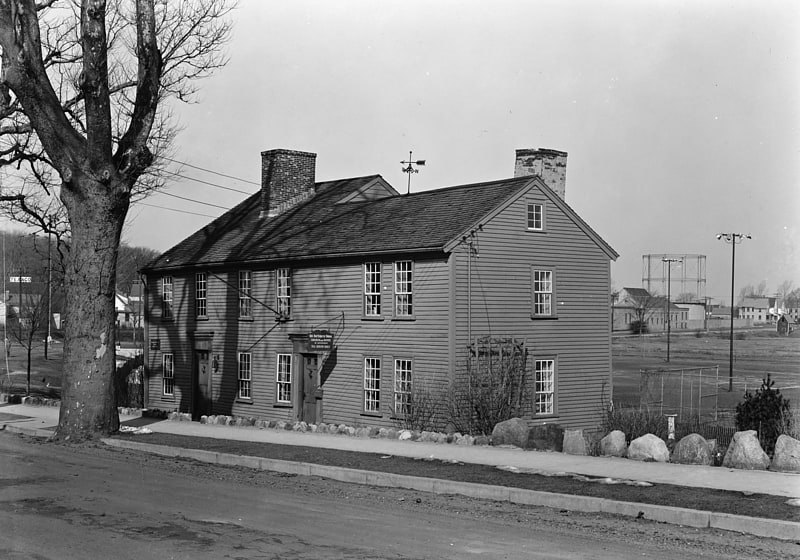
Historical place in Wakefield, Massachusetts. The Church–Lafayette Streets Historic District encompasses a well-preserved collection of late 18th- and early 19th-century houses in Wakefield, Massachusetts. It includes properties on Church Street between Common Street and North Avenue, and on Lafayette Street between Common and Church Streets. The district was added to the National Register of Historic Places in 1989.[4]
Meeting House of the Second Parish in Woburn
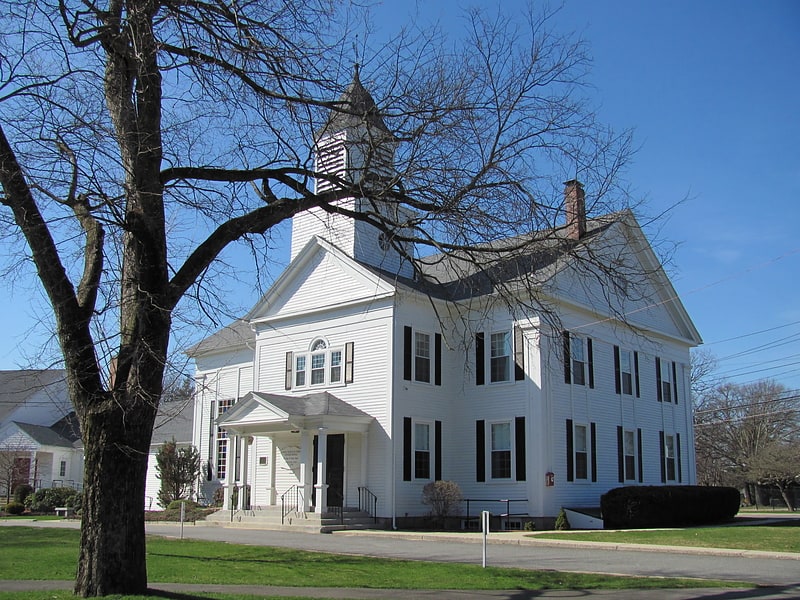
Building in Burlington, Massachusetts. The United Church of Christ, Congregational is a historic Congregational church in Burlington, Massachusetts. Built in 1732, it is one of the oldest religious structures in Massachusetts, and one of a small number of pre-19th century church buildings. It was redesigned in 1846 to bring it into the then-popular Greek Revival style, extending it in length and adding a somewhat Gothic-looking steeple. In 1888, when the Colonial Revival was becoming popular, a number of these changes were in effect reversed, restoring a more Colonial-style steeple.
When built, the area that is now Burlington was still part of Woburn, and this church was the second, built to serve what is now Burlington. It was the site in 1775 of some critical meetings, both military and political, of Patriots in the American Revolutionary War. The church served as a parish of Massachusetts' state funded church until the churches were disaffiliated from the state government in the early nineteenth century.
In 1909, Martha E. Sewall Curtis published, Ye olde meeting house : addresses and verses relating to the meeting house, Burlington, Middlesex County, Massachusetts, built 1732, and other historical addresses.
The meeting house was added to the National Register of Historic Places in 1990. The congregation is currently affiliated with the United Church of Christ.[5]
Temple Israel Cemetery
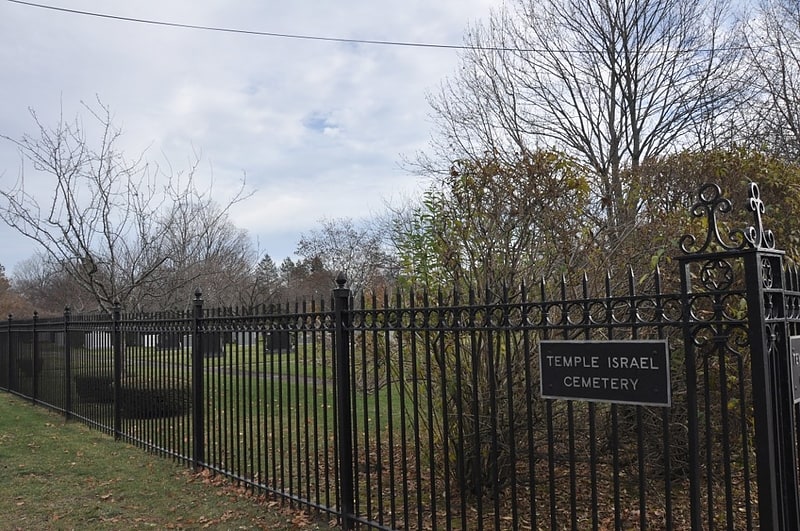
Cemetery in Wakefield, Massachusetts. Temple Israel Cemetery is a historic Jewish cemetery on North Avenue in Wakefield, Massachusetts. The cemetery was established by the Temple Israel congregation of Boston in 1859. Unlike the adjacent Lakeside Cemetery, whose landscape is of winding paths, this cemetery is laid out in a rectilinear grid. Stones are somewhat uniform in their content, often listing places of birth and death. Markers placed early in the cemetery's history are predominantly marble, while many of those placed in the 20th century are granite or limestone. The cemetery's most notable burial is that of Rabbi Joshua Liebman.
The cemetery was listed on the National Register of Historic Places in 1989.[6]
House at 15 Lawrence Street
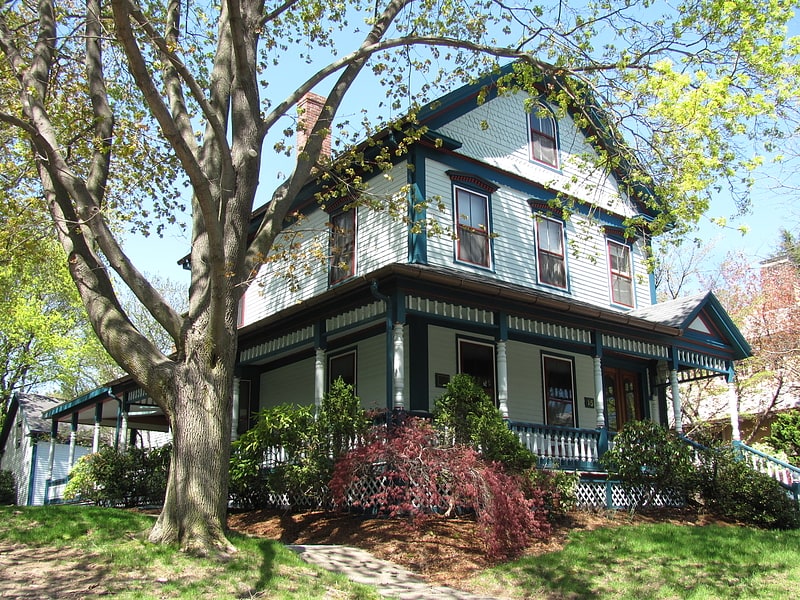
The House at 15 Lawrence Street in Wakefield, Massachusetts is a well-preserved Queen Anne house with a locally rare surviving carriage house. It was built in the early 1870s, and was listed on the National Register of Historic Places in 1989.[7]
House at 193 Vernon Street
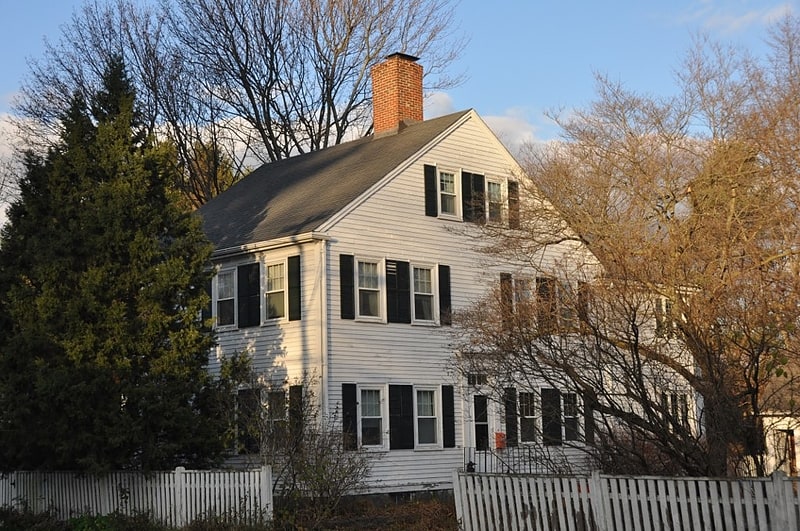
The House at 193 Vernon Street in Wakefield, Massachusetts is a late Federal-style house, built. c. 1840. The 2+1⁄2-story wood-frame house is a rare local example of a three-wide four-deep construction. It has a main entrance on the front facade that has sidelights and a pedimented entablature that were probably added later, and also has a side entrance with a Federal-style transom and sidelights. A late 19th-century barn stands behind the house, a reminder of the area's agricultural use.
The house was listed on the National Register of Historic Places in 1989.[8]
House at 9 White Avenue
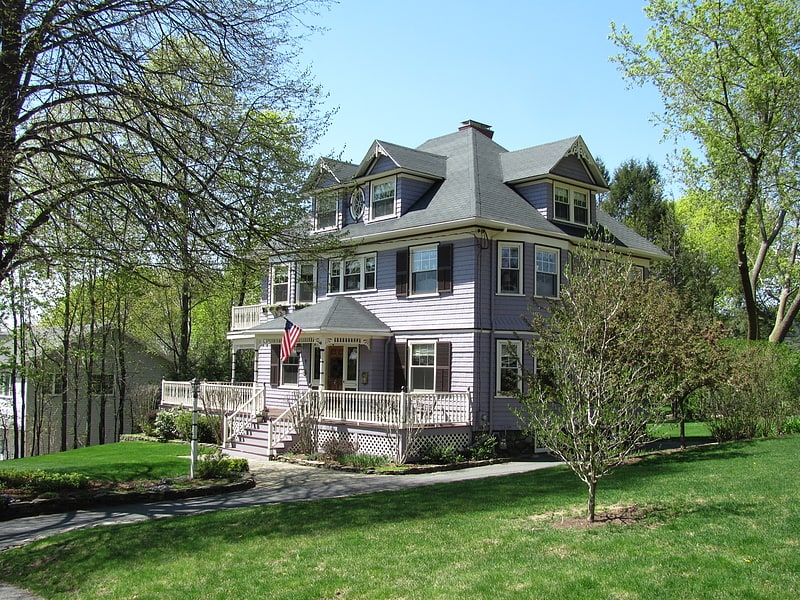
The House at 9 White Avenue in Wakefield, Massachusetts is a well-preserved transitional Queen Anne/Colonial Revival house. Built about 1903, it was listed on the National Register of Historic Places in 1989.[9]
House at 7 Salem Street

The House at 7 Salem Street in Wakefield, Massachusetts is a transitional Greek Revival/Italianate style house built c. 1855–57. The 2+1⁄2-story wood-frame house has a typical Greek Revival side hall plan, with door and window surrounds that are also typical to that style. However, it also bears clear Italianate styling with the arched window in the gable, and the paired brackets in the eaves. A single-story porch wraps around the front and side, supported by simple square columns. Its occupant in 1857 was a ticket agent for the Boston and Maine Railroad.
The house was listed on the National Register of Historic Places in 1989.[10]
Beacon Street Tomb
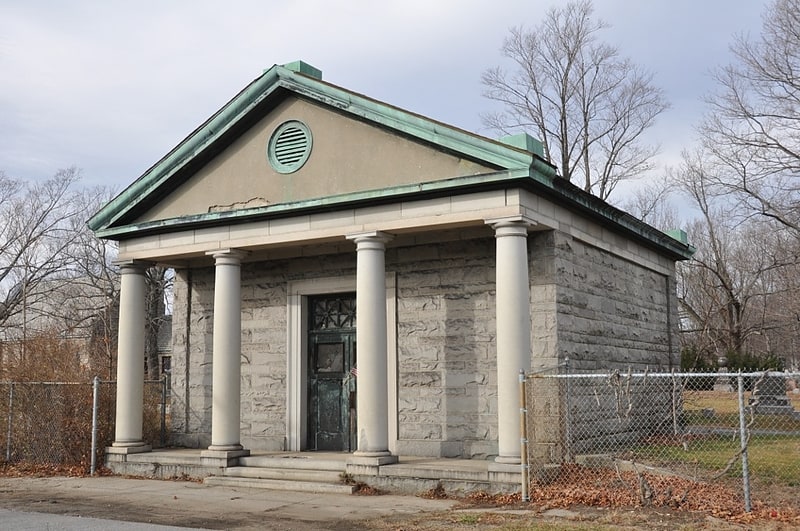
Tomb in Wakefield, Massachusetts. The Beacon Street Tomb is a historic receiving tomb in the Lakeside Cemetery of Wakefield, Massachusetts. Built about 1858, it is one of the finest examples of Greek Revival architecture. It was listed on the National Register of Historic Places in 1989.[11]
House at 509 North Avenue
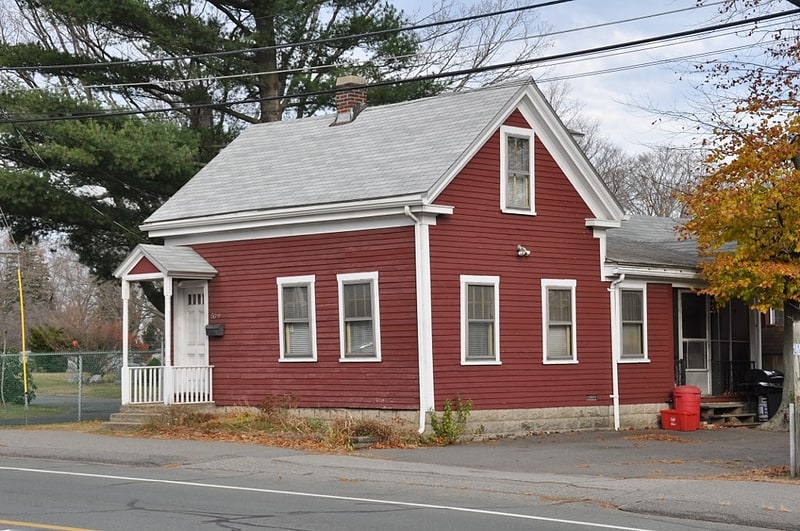
The House at 509 North Avenue in Wakefield, Massachusetts is a small Greek Revival cottage. The single story wood-frame house was built c. 1848 and moved to its present location c. 1869. The house is three bays wide and one deep, and exhibits very simple Greek Revival styling, including a boxed cornice and simple door and window surrounds. This house was probably built on land subdivided from holdings of ice companies working on nearby Lake Quannapowitt. Its earliest documented resident was listed in the town's 1869 directory as a shoemaker.
The house was listed on the National Register of Historic Places in 1989.[12]
Dr. Thomas Simpson House
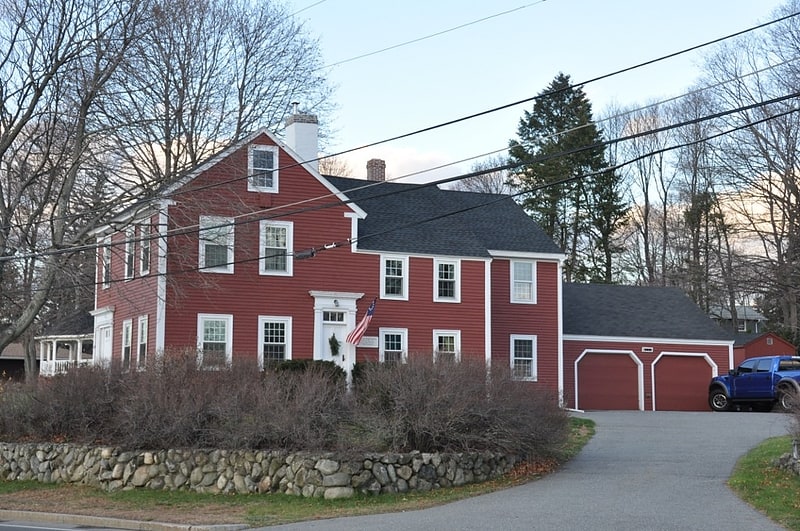
The Dr. Thomas Simpson House is a historic house at 114 Main Street in Wakefield, Massachusetts. It is a 2+1⁄2-story timber-frame house, in a local variant of Georgian style that is three bays wide and four deep, with a side gable roof. Its primary entrance, facing west toward Lake Quannapowitt, has sidelight windows and pilasters supporting an entablature, while a secondary south-facing entrance has the same styling, except with a transom window instead of sidelights. The core of this house was built by Dr. Thomas Simpson sometime before 1750, and has been added onto several times. It was restyled in the Federal period, when the door surrounds would have been added.
The house was listed on the National Register of Historic Places in 1989.[13]
United States Post Office–Wakefield Main
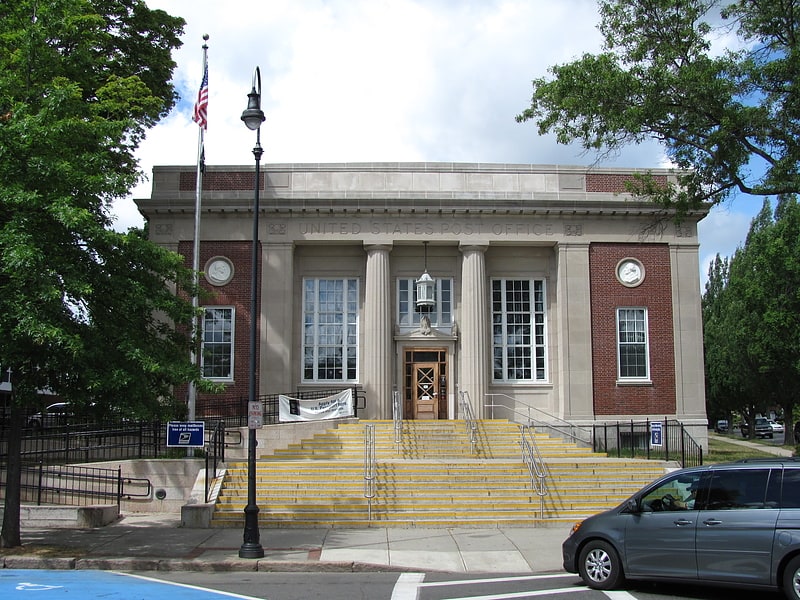
Post office in Wakefield, Massachusetts. The United States Post Office–Wakefield Main is a historic post office building at 321 Main Street in Wakefield, Massachusetts. Built in 1936 as part of a Depression-era works project, it is a Classical Revival structure that harmonizes with its neighbors. The building was listed on the National Register of Historic Places in 1987, and included in the Common District in 1990.[14]
Deacon Thomas Kendall House
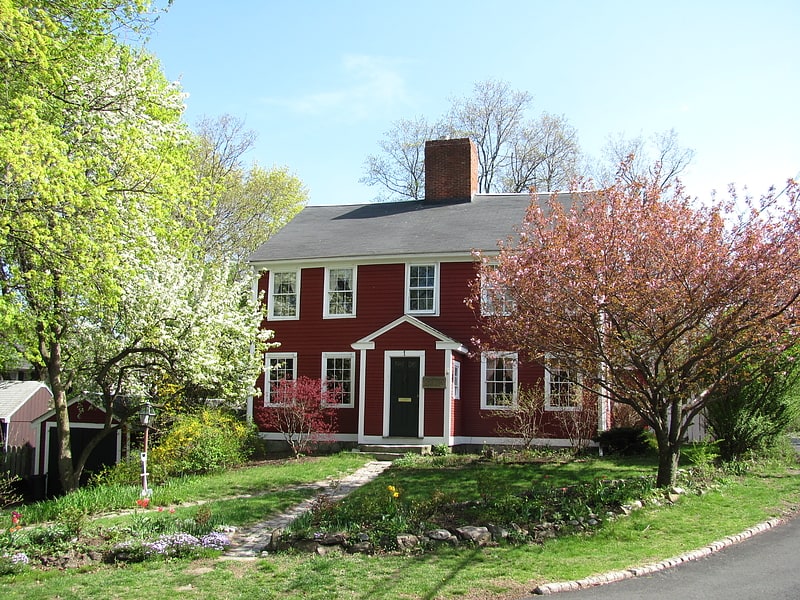
The Deacon Thomas Kendall House is a historic house at One Prospect Street in Wakefield, Massachusetts. This timber frame, 2+1⁄2-story five-bay house has Federal styling, but its massive central chimney indicates that parts of the house likely predate the Federal period, and in a style that predates 1750. The house is believed to have suffered fire damage in 1786 and been reconstructed at that time, incorporating salvaged materials. Its exterior trim exhibits several different styles, that on the north and west sides more finely carved. The second-floor windows on the south side are smaller and set near the eaves, a typical colonial period feature. The house was listed on the National Register of Historic Places in 1989.
Deacon Thomas Kendall was an influential member of the community, serving as a selectman, commissioner, and deacon of the church for 36 years. He and his wife, Rebecca, had 10 children, and when she died, at the age of 85, she had 175 grandchildren and great-grandchildren. The Kendalls were among the earliest settlers of the Reading area (of which Wakefield was a part until the 19th century). The house was owned for much of the 19th century by the Emerson family, who also owned it at the time of the 1786 fire.[15]
Lucius Beebe Memorial Library
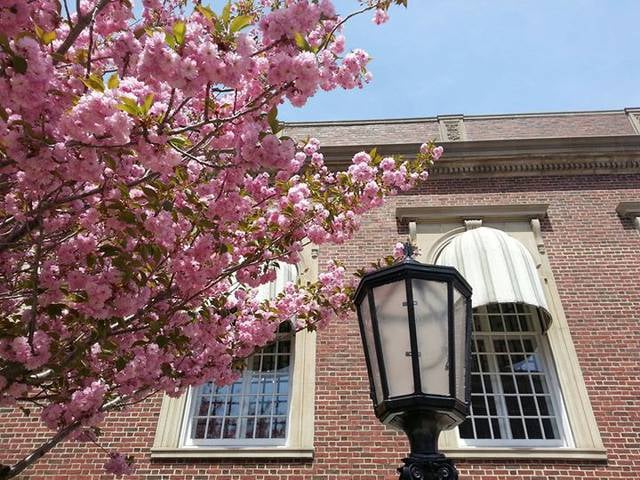
Library
Address: 345 Main Street, Wakefield (Wakefield)
House at 40 Crescent Street

40 Crescent Street is a historic house in Wakefield, Massachusetts, and is significant as a particularly fine example of a Greek Revival style house.[16]
Flanley's Block
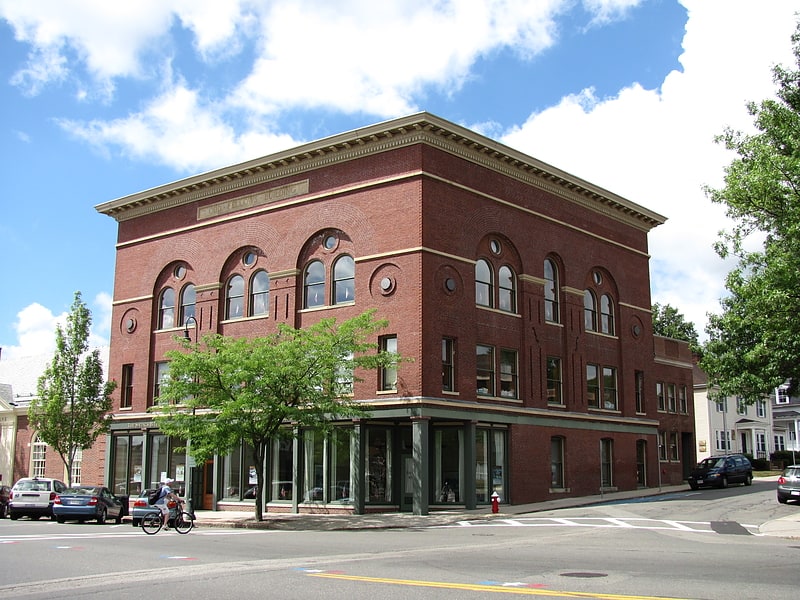
Building in Wakefield, Massachusetts. Flanley's Block is a historic commercial building at 349–353 Main Street in Wakefield, Massachusetts, US. Built about 1895, it is a well-preserved local example of late 19th-century Italianate commercial architecture. The building was listed on the National Register of Historic Places in 1989.[17]
House at 21 Chestnut Street
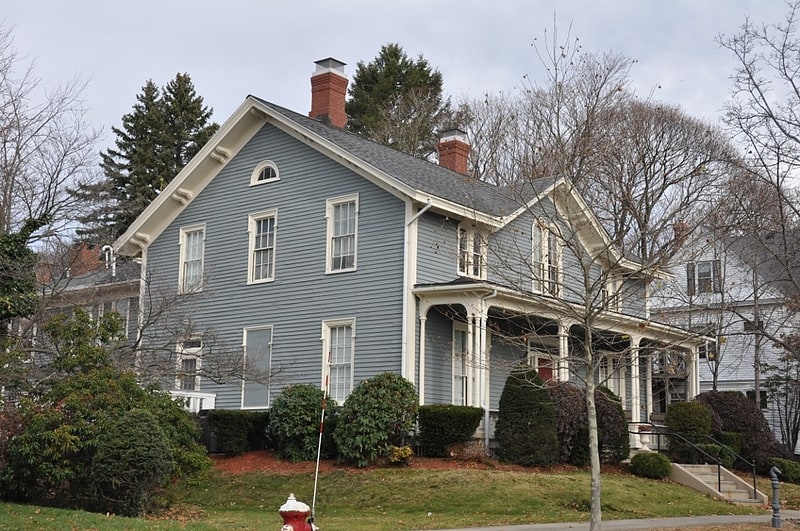
The House at 21 Chestnut Street is one of the best preserved Italianate houses in Wakefield, Massachusetts. It was built c. 1855 to a design by local architect John Stevens, and was home for many years to local historian Ruth Woodbury. The house was listed on the National Register of Historic Places in 1989.[18]
House at 18 Park Street
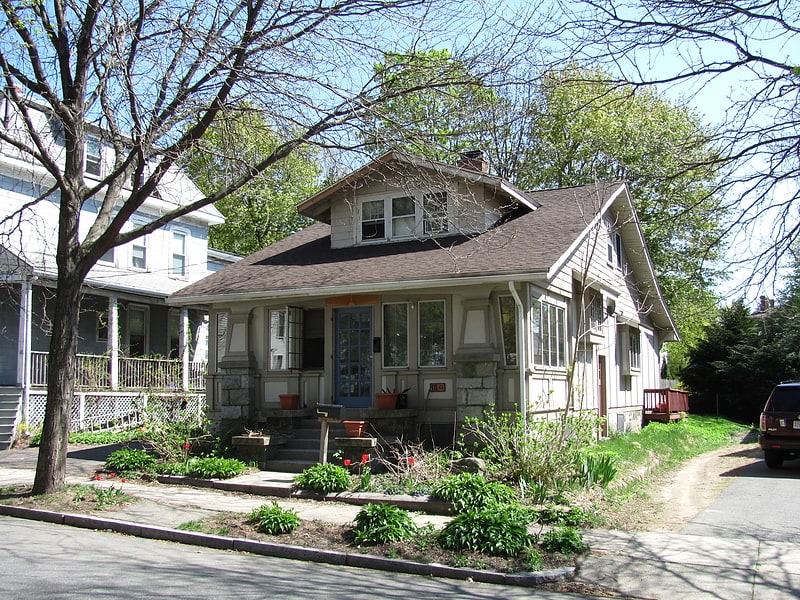
Building in Wakefield, Massachusetts. The House at 18 Park Street, also known as the Clarence A. Van Derveer House, is a historic house at 18 Park Street in Wakefield, Massachusetts. The 1+1⁄2-story Craftsman/Bungalow style house was built in 1922 by Clarence A Van Derveer, a real estate broker who lived next door and subdivided his lot to build this house. It has classic Craftsman features, including exposed rafters under extended eaves, and paneled porch pillars and rails.
The house was listed on the National Register of Historic Places in 1989.[19]
House at 28 Cordis Street
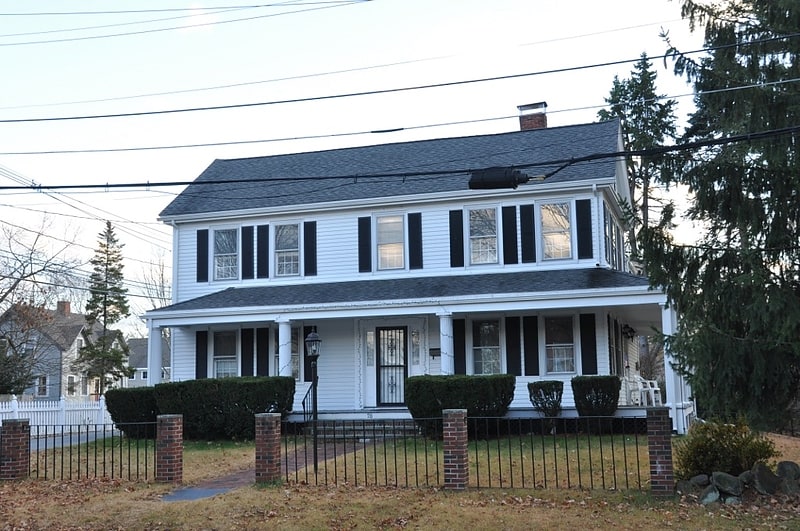
28 Cordis Street is a historic house located in Wakefield, Massachusetts. It is significant as a well-preserved example of the Greek Revival style houses built during the early to mid 19th century.[20]
E. Boardman House

The Elias Boardman House is a historic house at 34 Salem Street in Wakefield, Massachusetts. Built in 1820, it is one of the city's most elaborate examples of Federal period architecture. It was built by Elias Boardman, and was dubbed Boardman's Folly for its extravagance. It was listed on the National Register of Historic Places in 1989.[21]
Captain Goodwin–James Eustis House

The Captain Goodwin–James Eustis House is a historic house in Wakefield, Massachusetts. Built about 1760 and enlarged around 1830, it is a good local example of Greek Revival architecture, which was owned by a prominent local businessman and civic leader. The house was listed on the National Register of Historic Places on March 2, 1990, where it is listed as the "Captain Goodwin–James Custis House".[22]
House at 19–21 Salem Street
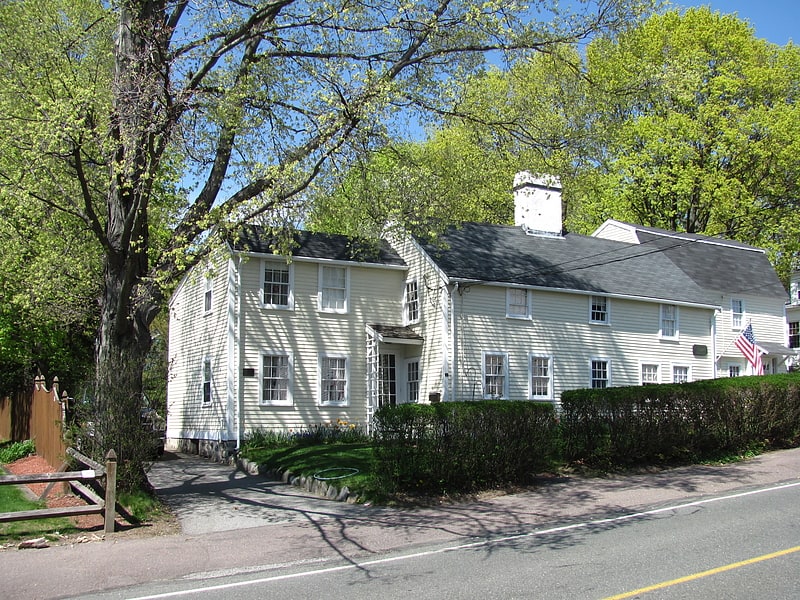
Building in Wakefield, Massachusetts. The House at 19–21 Salem Street in Wakefield, Massachusetts is an unusual 18th-century two-family residence. It is composed of two different houses that were conjoined c. 1795. The left house has a gabled roof and asymmetrical window placement, while the right house has a gambrel roof and an early 20th-century entry hood. It is probable that both houses were built by Joseph Gould, who occupied the eastern of the two houses, between 1765 and 1795. Despite subsequent alterations, the Georgian/Federal styling of the building remains apparent.
The house was listed on the National Register of Historic Places in 1989.[23]
House at 2 Nichols Street
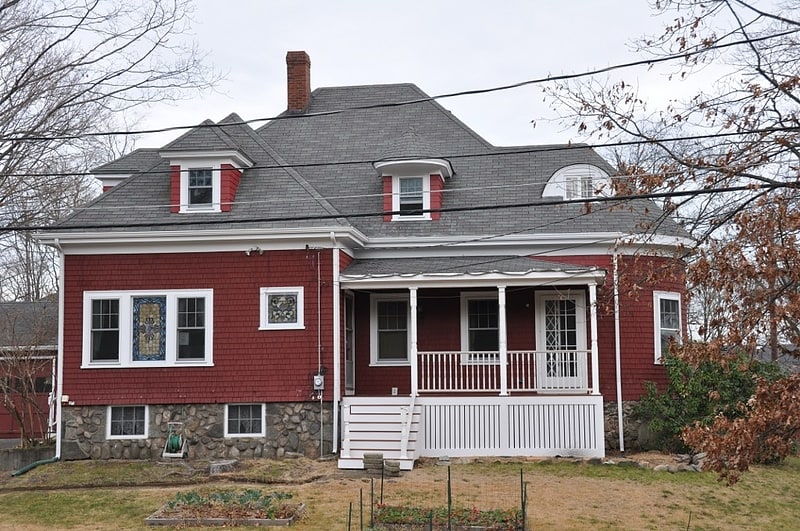
The House at 2 Nichols Street in Wakefield, Massachusetts, is a well-preserved, architecturally eclectic house built in the 1890s. The 1+1⁄2-story frame house has elements of the Tudor Revival, Queen Anne, and Shingle styles, and is one of two identical houses built by local builder Berndt Heurlin. It has a hip roof, but transverse gables, one of which has a rounded bay, giving it a Queen Anne feel. The foundation exterior is fieldstone, and there are several stained glass windows.
The house was listed on the National Register of Historic Places in 1989.
The house was also the childhood home of the renowned Swedish-American artist, Magnus Colcord Heurlin (July 5, 1895 – March 10, 1986). Colcord Heurlin attended the Fenway School of Illustration in Boston, MA, where he studied under Harold Mathews Brett (1880-1955), the director of the newly opened school. Heurlin began illustrating covers for pulp magazines in the 1920s and 1930s and later joined the WPA Federal Arts Project, creating two murals for the Bedford Elementary School in Westport, CT. But he is best known for his vivid, oil-pastel depictions of Alaskan natives and early settler life in northern Alaska.[24]
House at 15 Wave Avenue
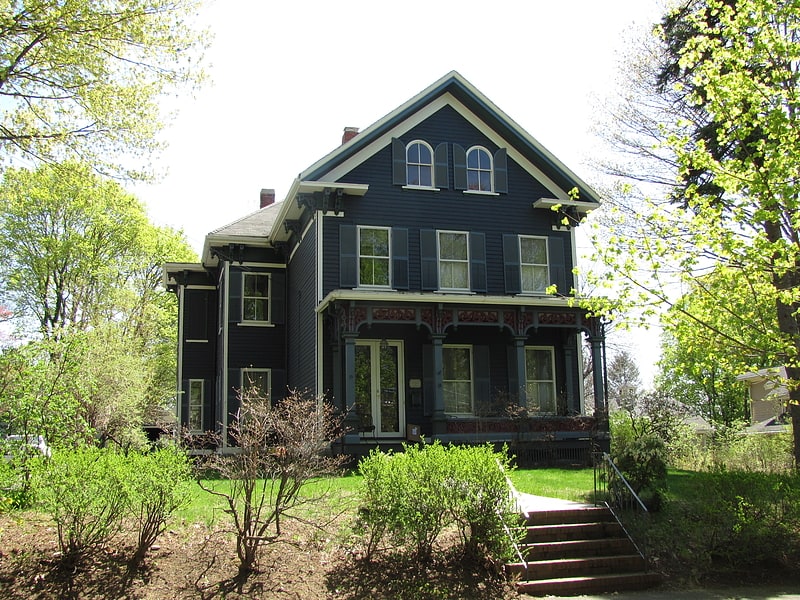
15 Wave Avenue is a well-preserved Italianate style house in Wakefield, Massachusetts. It was built between 1875 and 1883, and was listed on the National Register of Historic Places on July 6, 1989.[25]
House at 20 Lawrence Street
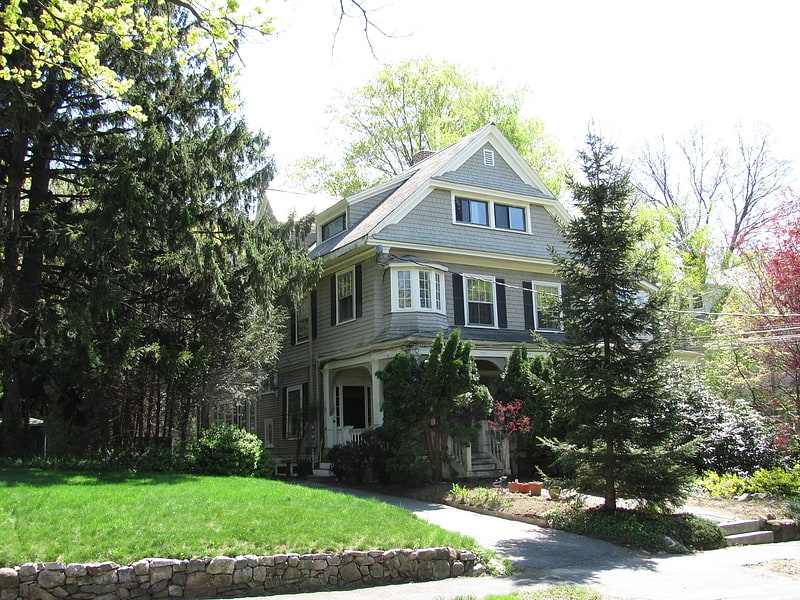
The House at 20 Lawrence Street in Wakefield, Massachusetts is a complex residential structure with elements of Queen Anne, Stick style, and Colonial Revival style. Built about 1880, it was listed on the National Register of Historic Places in 1989.[26]
House at 5 Bennett Street
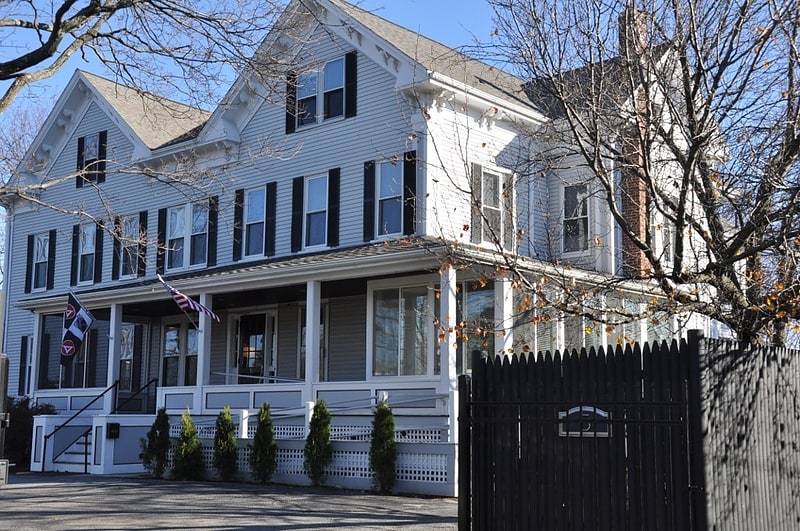
Building in Wakefield, Massachusetts. The House at 5 Bennett Street in Wakefield, Massachusetts, is also known as the Wakefield House for Aged Women, and is one of the largest houses in Wakefield's Junction District. The original part of the house was built sometime between 1875 and 1881, with Italianate styling. It was probably built for an executive of the Wakefield Rattan Company. In 1894 the house was purchased by the Wakefield House for Aged Women, a charity established by local Protestant churches, and significantly expanded. During this major alteration some of the house's Italianate details were copied, and a Queen Anne style porch was added.
The building was listed on the National Register of Historic Places in 1989.[27]
Buildings at 35–37 Richardson Avenue
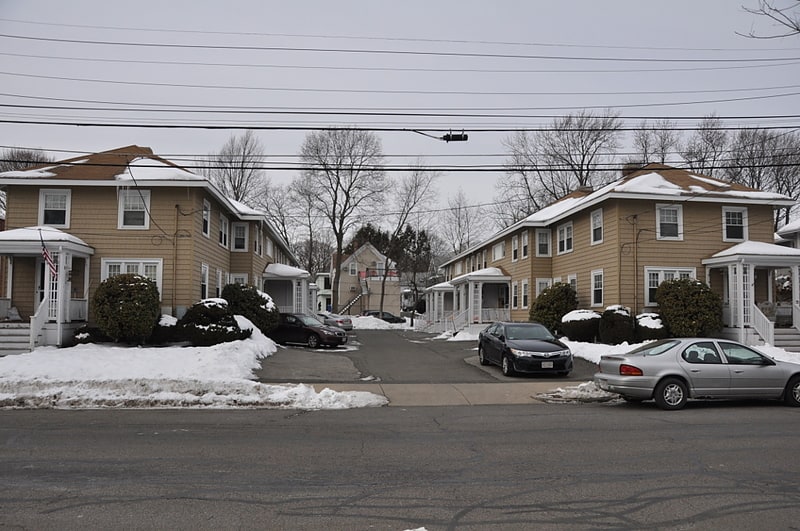
Building in Wakefield, Massachusetts. The buildings at 35–37 Richardson Avenue are historic rowhouses in Wakefield, Massachusetts. These two rowhouses, built c. 1912–15, are among the earliest apartment blocks built in the town. They were built by Solon O. Richardson, Jr. on a portion of his estate. The buildings were listed on the National Register of Historic Places in 1989.[28]
Emerson–Franklin Poole House
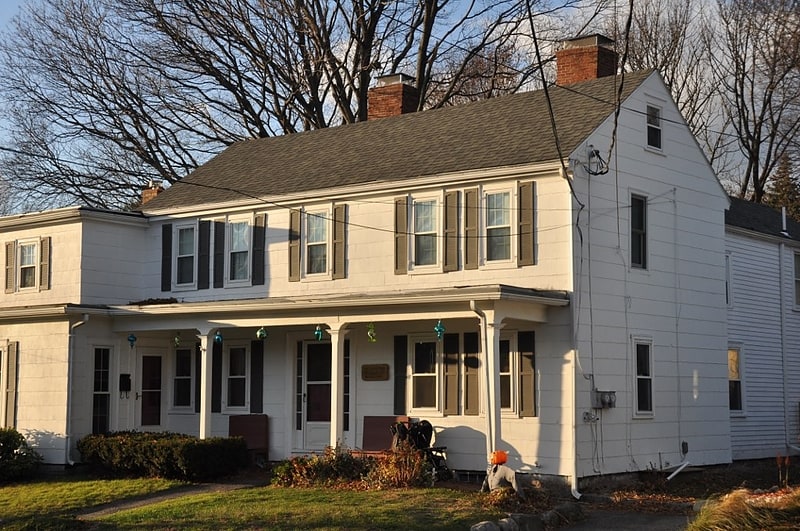
The Emerson–Franklin Poole House is a historic house at 23 Salem Street in Wakefield, Massachusetts. Built about 1795, it was in the 19th century home to Franklin Poole, a locally prominent landscape artist. Some of its walls are adorned with the murals drawn by Rufus Porter. The house was listed on the National Register of Historic Places in 1989.[29]
Building at 38–48 Richardson Avenue
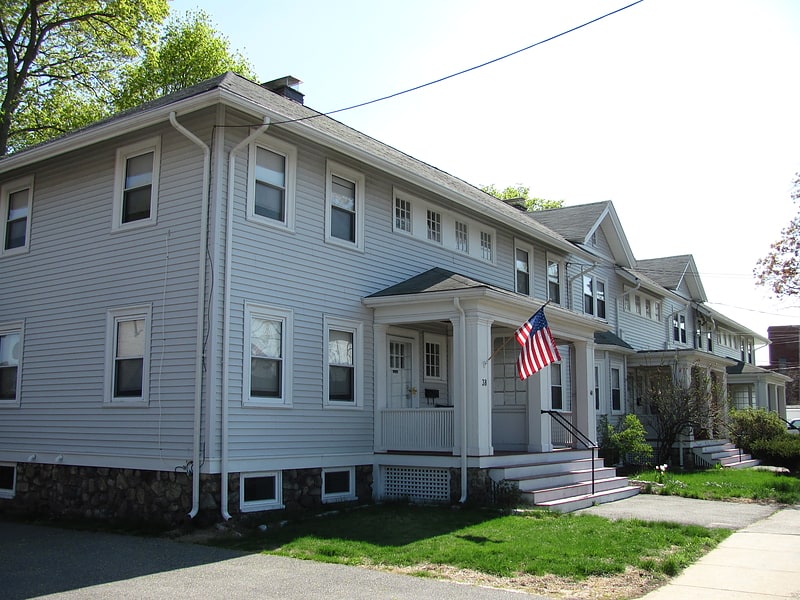
Building in Wakefield, Massachusetts. The building at 38–48 Richardson Avenue is a historic residential rowhouse in Wakefield, Massachusetts. Built c. 1912, is believed to be one of the oldest rowhouses in the town. They were built by Solon O. Richardson, Jr. on a portion of his family's estate. The building was listed on the National Register of Historic Places in 1989.[30]
House at 12 West Water Street

The House at 12 West Water Street in Wakefield, Massachusetts is a rare local example of a Second Empire house. The wood-frame house was built around 1860, and has two full stories, and a third beneath the mansard roof. It is three bays wide, with a wide double-door entry, and a porch across the front with elaborately decorated posts. The house may have been built by Cyrus Wakefield, owner of the Wakefield Rattan Company, and sold to a company employee. A later owner was George Cox, who owned a billiard parlor in the town center.
The house was listed on the National Register of Historic Places in 1989.[31]
Item Building
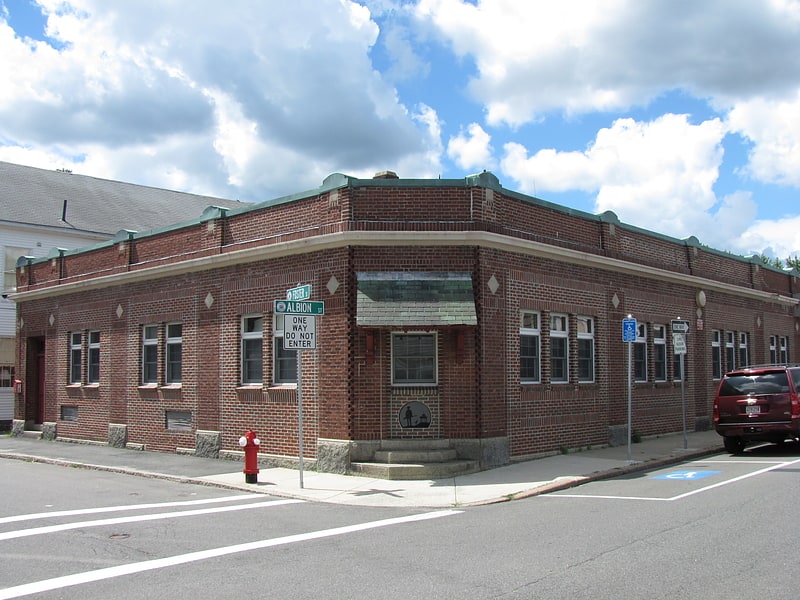
Building in Wakefield, Massachusetts. The Item Building is a historic commercial building at 26 Albion Street in Wakefield, Massachusetts. Built in 1912, the single story brick building serves as the headquarters of The Wakefield Daily Item, Wakefield's main community newspaper, and is a well-kept example of early 20th century commercial architecture.[32]
House at 190 Main Street
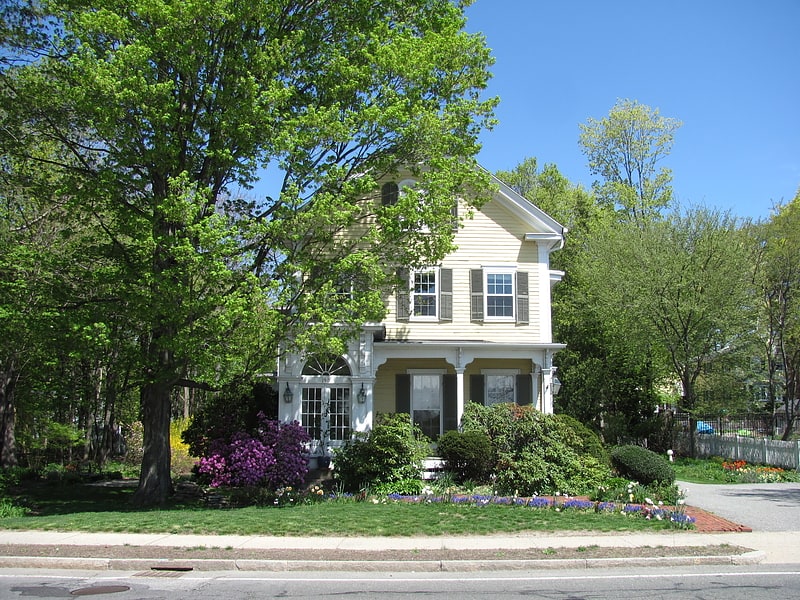
The House at 190 Main Street, also known as the William F. Young House, is a historic house at 190 Main Street in Wakefield, Massachusetts. The exact construction date of the 2+1⁄2-story wood-frame house is uncertain: it follows a traditional three bay side hall plan, but was also extensively remodeled sometime before 1870 with Italianate styling, probably by William F. Young, a commuter who worked at a grocery firm in Boston. It has a round-arch window in the front gable end, and its porch features narrow chamfered posts topped by a flat arched frieze. The main entry portico is closed in, and it and the porch feature decorative brackets.
The house was listed on the National Register of Historic Places in 1989.[33]
House at 25 Avon Street
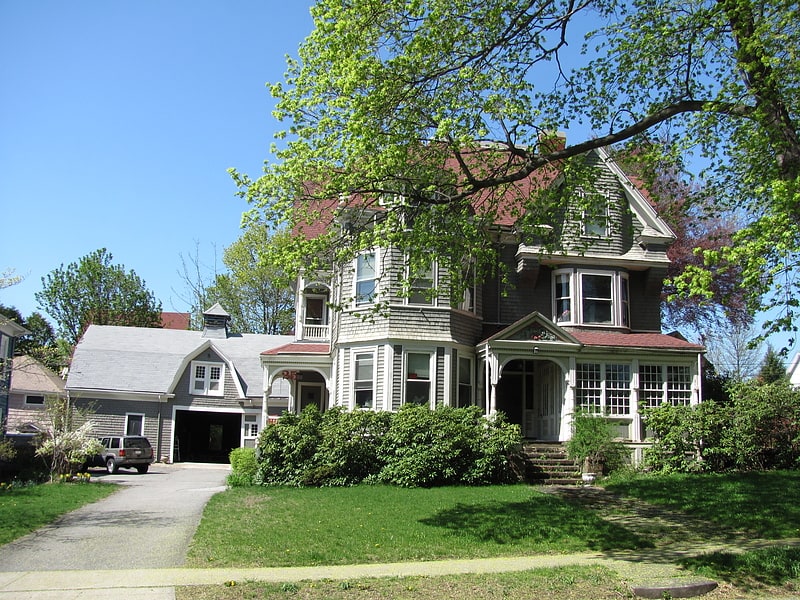
25 Avon Street is a historic house, and is significant as one of the more elaborate Queen Anne Victorian houses in the town of Wakefield, Massachusetts.[34]